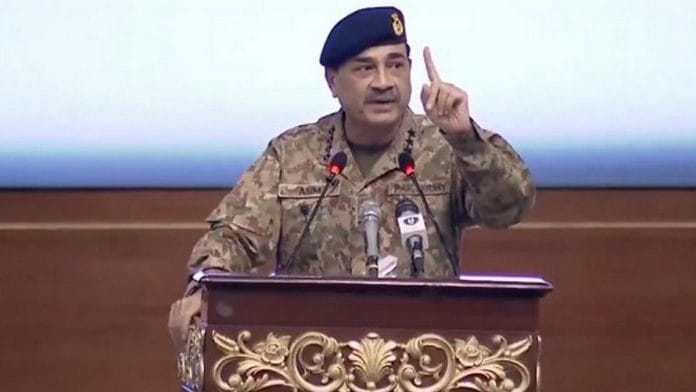Thank you dear subscribers, we are overwhelmed with your response.
Your Turn is a unique section from ThePrint featuring points of view from its subscribers. If you are a subscriber, have a point of view, please send it to us. If not, do subscribe here: https://theprint.in/
On 12th May, India has delivered a blunt message to the world: ‘Don’t ask us to restrain ourselves — we won’t listen. Instead, restrain Pakistan.’
Prime Ministers declaration that India will no longer tolerate nuclear blackmail is a distinct and strategic shift in India’s security doctrine, signalling a readiness to call Pakistan’s bluff on its nuclear posture and retaliate against cross-border terrorism without restraint. Alongside this, he emphasized that India would no longer differentiate between terrorist organizations and the state sponsors behind them, effectively erasing the line between non-state actors and the Pakistani military establishment. He also announced that Operation Sindoor represents a new doctrine of decisive, proactive military retaliation, framing it as the “new normal” in India’s counter-terrorism strategy.
Additionally, the decision to suspend the Indus Waters Treaty underscored India’s readiness to leverage economic and environmental pressure as strategic tools, indicating a shift from mere military retaliation to a multidimensional assertion of national power. Collectively, the message to the world is clear: ‘Stop urging India to hold back — it’s time to hold Pakistan accountable.’
India’s response to the April 22 terrorist attack in Pahalgam, Jammu and Kashmir, which resulted in the deaths of 26 civilians, underscores this change in doctrine. The subsequent launch of Operation Sindoor was not just a retaliatory strike but a deliberate assertion of India’s newfound willingness to cross previously respected red lines.
India’s use of missile strikes against Bahawalpur and Muzaffarabad — both key urban centers in Pakistan-administered territory — signals a calibrated escalation that goes beyond the tactical surgical strikes of 2016 or the Balakot airstrikes of 2019. This shift also marks a strategic evolution in India’s response to a long history of cross-border terrorism, from the audacious Kargil intrusion in 1999 to the devastating attack on the Indian Parliament in 2001, and the calculated carnage of the 2008 Mumbai terror strike that saw the iconic Taj Hotel engulfed in flames.
Each of these incidents was met with a mix of diplomatic outrage and limited military action, but Operation Sindoor’s missile strikes convey a new level of strategic resolve — a willingness to target critical infrastructure in urban areas, irrespective of the international fallout.
Prime Ministers speech following the operation crystallized this new posture. Declaring that India would no longer distinguish between terrorists and their state sponsors, he set a stark new standard: any future terrorist attack on Indian soil would be met with a military response targeting both militant groups and their patrons. The deliberate broadening of the target set effectively erases the line between non-state actors and the Pakistani military establishment. In doing so, he has redefined the scope of military retaliation — and perhaps more significantly, he has communicated to the world that India will act unilaterally, if necessary, irrespective of international opinion.
The most striking element of the speech was his categorical rejection of nuclear blackmail. For decades, Pakistan’s nuclear arsenal has acted as a strategic deterrent against Indian retaliation, effectively allowing Islamabad to conduct proxy warfare through militant groups while shielding itself behind its nuclear capabilities. This statement that India will not be restrained by nuclear threats marks a significant recalibration of India’s strategic calculus. It suggests that New Delhi is prepared to absorb and respond to limited nuclear brinkmanship, effectively calling Pakistan’s bluff and raising the stakes for future conflict.
India’s suspension of the Indus Waters Treaty further underscores the strategic shift from restraint to assertiveness. The 1960 treaty, brokered by the World Bank, has long been held up as a model of conflict resolution, even amid wars and crises. By suspending its participation, India is signalling that even existing bilateral agreements are now contingent upon Pakistan’s behaviour. This is economic warfare by other means, targeting a critical vulnerability in Pakistan’s agricultural and hydropower sectors. In effect, India is leveraging its upper riparian status to exert coercive pressure, linking water security to regional security — a linkage with profound implications for future conflict dynamics.
The international response to India’s new posture has been mixed. The global community appears uncertain how to respond to India’s newfound assertiveness. For decades, the international consensus has been to urge restraint on both sides, especially on India, and discouraging conventional military escalation.
This presents a diplomatic conundrum for global powers. If they condemn India’s actions, they risk alienating a strategic partner in the Indo-Pacific, a region increasingly viewed as a counterweight to China’s assertiveness. If they remain silent, they effectively endorse India’s shift to a more aggressive doctrine, potentially encouraging further escalations. In either scenario, the international community is now faced with a stark choice — pressure Pakistan to rein in its militant proxies or accept that India will impose its own cost calculus, regardless of global opinion.
In conclusion, India’s strategic messaging is unmistakable: ‘Don’t ask us to restrain ourselves — we won’t listen. Instead, restrain Pakistan.’ This blunt, uncompromising stance represents a dramatic shift from decades of strategic restraint to a doctrine of proactive, punitive deterrence. While the long-term consequences of this shift remain uncertain, the immediate impact is clear — the regional balance of power has been recalibrated, and India has established itself as a state willing to use its military and economic leverage to enforce its red lines. Whether this strategy can be sustained without provoking unintended consequences remains the critical question.
These pieces are being published as they have been received – they have not been edited/fact-checked by ThePrint.


